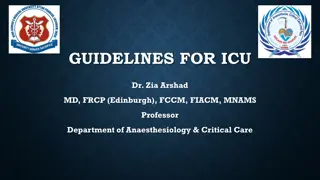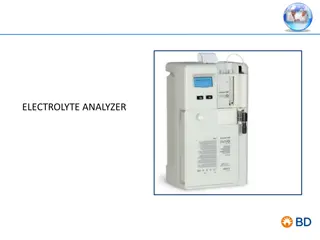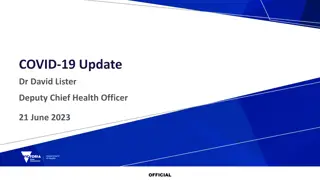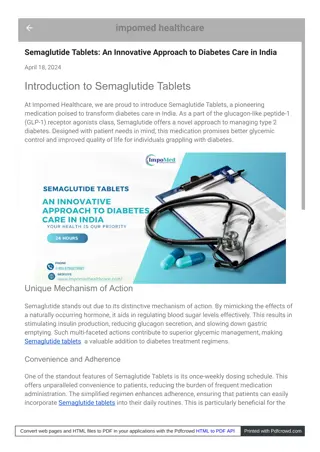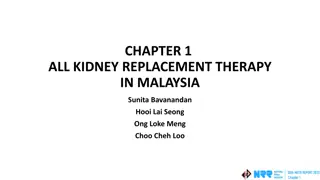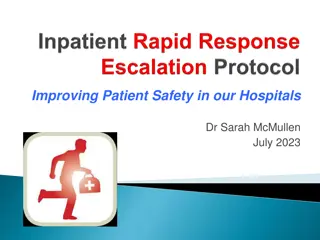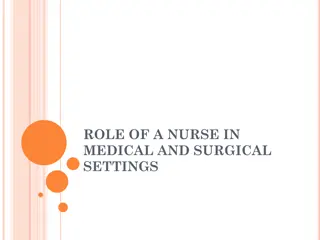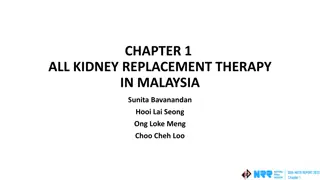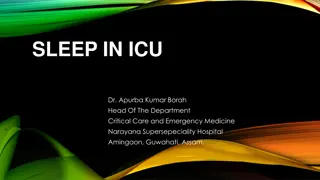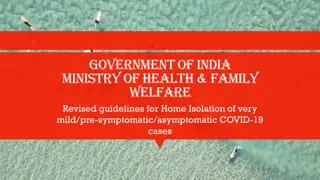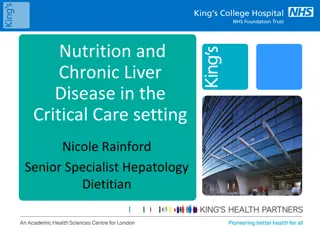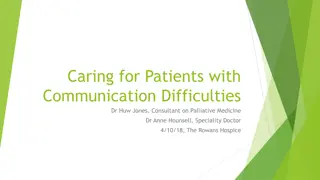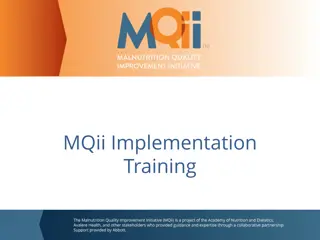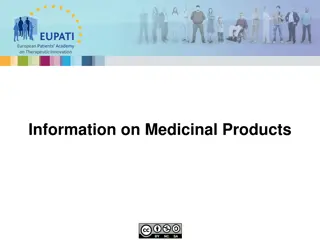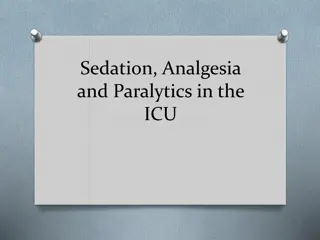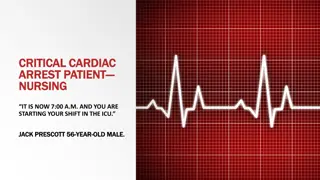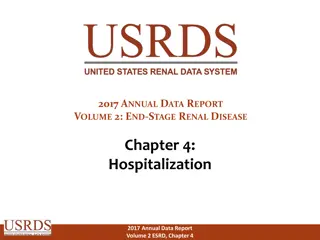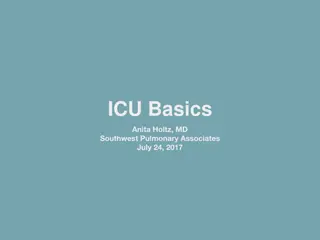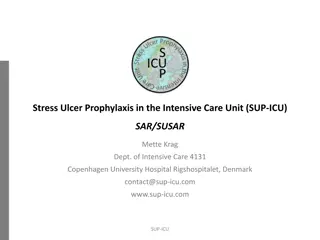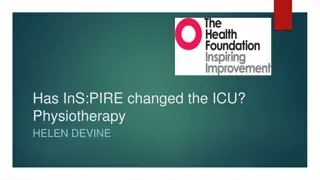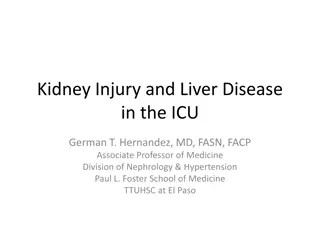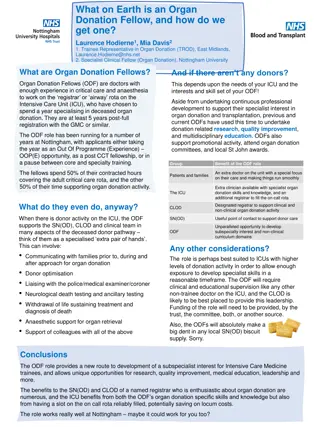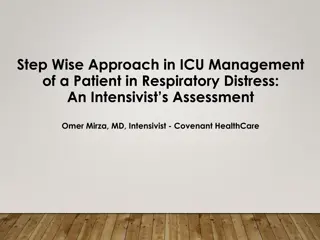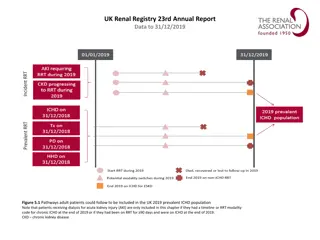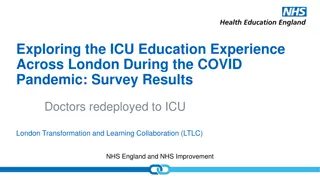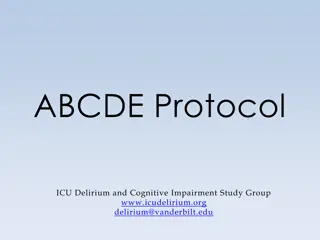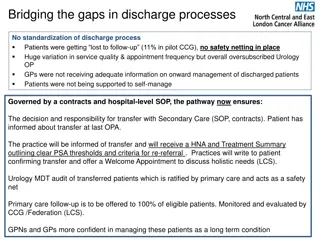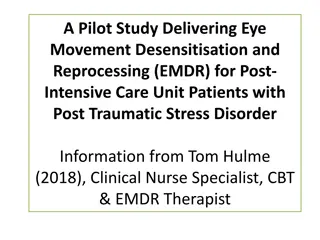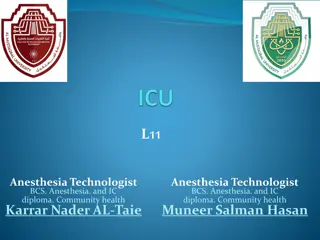Comprehensive ICU Protocol for Sedation, Analgesia, and Delirium Control by Dr. Vinod Srivastava
This comprehensive ICU protocol by Dr. Vinod Srivastava, an Associate Professor in Anaesthesiology & Critical Care at KGMU, covers key aspects such as sedation, analgesia, delirium assessment and control, stress ulcer and deep vein thrombosis prophylaxis, and glycaemic control in the ICU setting. Th
1 views • 50 slides
PKB - Patients Know Best
PKB (Patients Know Best) is a patient-held record platform that empowers patients to access and manage their health information effectively. It enables patients to track symptoms, connect devices, share data with clinical teams, and engage in self-care. With features like communication tools, sympto
0 views • 10 slides
Guidelines for Intensive Care Unit (ICU) Management by Dr. Zia Arshad
Dr. Zia Arshad provides comprehensive guidelines for managing patients in the ICU, including admission criteria, monitoring protocols, handling lab investigations, communication procedures, and post-mortem care. The guidelines emphasize meticulous documentation, compassionate patient care, infection
0 views • 28 slides
Understanding Antibiotic Therapy in the ICU: Strategies and Considerations
Delve into the world of antibiotic therapy in the intensive care unit (ICU) with a focus on identifying the enemy pathogens, selecting the appropriate antibiotics, and formulating effective treatment plans. Explore the nuances of Gram-positive and Gram-negative bacteria, along with other key bacteri
3 views • 76 slides
Fluid Management in ICU: Understanding Body Fluid Compartments and Types of Fluids
Fluid management in the ICU is crucial for patient care. This includes understanding the distribution of body fluid compartments, such as intravascular, interstitial, and intracellular fluids. Different types of fluids like crystalloids and colloids play essential roles in treatment. Crystalloids ar
3 views • 26 slides
Nursing Care for Ventilator-Associated Pneumonia (VAP)
Ventilator-Associated Pneumonia (VAP) is defined as lung parenchyma inflammation occurring 48 hours or more after endotracheal intubation and mechanical ventilation initiation. It is a common nosocomial infection in ICU patients, with significant morbidity and mortality rates. Etiology of VAP involv
2 views • 24 slides
Understanding Electrolyte Analyzers in Medical Settings
Electrolyte analyzers play a crucial role in monitoring electrolyte levels for patients in various medical scenarios, including emergency departments, ICU admissions, and those with liver and kidney disorders. This technology utilizes Flame Emission Photometry and Ion Selective Electrode (ISE) techn
5 views • 6 slides
COVID-19 Update and Vaccination Status in Victoria as of June 21, 2023
Hospitalisation summary shows a decrease in COVID+ patients in hospital and ICU. Wastewater genomics provide insights into case incidence. Statewide deaths have decreased slightly. Excess deaths in Victoria are compared across years, and vaccination coverage data highlights the need for boosters in
2 views • 7 slides
Understanding Semaglutide Tablets: Key Insights for Indian Patients
Impomed Healthcare empowers Indian diabetes patients with comprehensive guidance on the innovative Semaglutide tablets. We explain how these tablets offer the dual benefits of blood sugar control and weight management through their unique mechanism. Our insights into Semaglutide help patients make i
11 views • 3 slides
Kidney Replacement Therapy Incidence Trends in Malaysia
The data presented in this study outlines the stock and flow of new Kidney Replacement Therapy (KRT) patients in Malaysia from 2012 to 2022. It covers the incidence rates of new dialysis patients, hemodialysis (HD) patients, peritoneal dialysis (PD) patients, and transplant patients. The figures and
1 views • 12 slides
Improving Patient Safety in our Hospitals
Dr. Sarah McMullen discusses the importance of early recognition and treatment of clinical deterioration in hospital settings to improve patient outcomes. Key points include identifying abnormal clinical antecedents, implementing early warning systems like NEWS2 and CHEWS, screening patients for cri
3 views • 35 slides
Role of a Nurse in Medical and Surgical Settings
The primary role of a nurse in medical and surgical settings is to provide direct care to adult patients in various healthcare facilities such as hospitals, clinics, homes, and surgical centers. Nurses play a crucial role in outpatient departments (OPD), inpatient departments (IPD), intensive care u
0 views • 16 slides
Kidney Replacement Therapy Trends in Malaysia 2012-2022
A comprehensive overview of kidney replacement therapy (KRT) trends in Malaysia from 2012 to 2022 is presented, detailing the stock and flow of new KRT incidences and ESKD patients on KRT. The data includes the number of new dialysis patients, new HD patients, new PD patients, and new transplant pat
0 views • 12 slides
Understanding Sleep Patterns and Architecture in the ICU Setting
Sleep in the ICU is crucial for physiological rest and emotional well-being, but it is often disrupted due to various factors. Normal sleep architecture consists of REM and Non-REM sleep cycles, each vital for different restorative processes. Non-REM sleep has three stages, including deep sleep impo
0 views • 25 slides
Understanding Ward Management in Healthcare Settings
Ward management involves optimizing resources in a ward to provide maximum care and comfort to patients. It includes functions like accommodation, treatment, recovery support, training opportunities, and research possibilities. Different types of wards exist, such as general wards and specific wards
2 views • 25 slides
Revised Guidelines for Home Isolation of COVID-19 Cases in India
The Ministry of Health & Family Welfare in India has issued revised guidelines for home isolation of very mild/pre-symptomatic/asymptomatic COVID-19 cases. Patients eligible for home isolation must have the necessary facility for self-isolation. Special considerations apply to elderly patients and t
2 views • 16 slides
Nutritional Considerations for Chronic Liver Disease in Critical Care
Malnutrition is common in chronic liver disease, leading to complications such as ascites and infections. Sarcopenia and weight loss are prevalent regardless of BMI. Critical care patients with liver disease face challenges due to limited physiological reserve, with main causes for ICU admission bei
1 views • 17 slides
Molecularly-Guided Therapy vs Platinum Chemotherapy in CUP Patients
This trial aims to compare the efficacy and safety of molecularly-guided therapy or cancer immunotherapy based on genomic profiling with platinum-based chemotherapy in patients with cancer of unknown primary site. The study design includes multiple treatment regimens guided by genomic profiles, with
4 views • 9 slides
Communicating with Patients with Cognitive Impairment and Other Communication Difficulties
This presentation highlights the causes of communication difficulties in patients, focusing on cognitive impairment, sensory impairments, and language barriers. It emphasizes the challenges of caring for these patients, including assessing pain and managing symptoms effectively. Practical strategies
0 views • 27 slides
Understanding Dysphagia in the ICU: Assessment and Impact
Dysphagia, the difficulty in swallowing, is a common issue in the ICU, affecting a significant percentage of intubated patients. It increases mortality, risk of pneumonia, malnutrition, and prolongs hospital stays. Assessment methods like bedside evaluation and FEES are crucial in managing dysphagia
5 views • 8 slides
Implementing MQii for Patient-Centered Care
Implementing the Malnutrition Quality Improvement Initiative (MQii) involves training project teams, understanding clinical workflows, and engaging patients in their care. Multidisciplinary project and care teams play essential roles in effective implementation, with patients and family caregivers c
5 views • 33 slides
European Patients Academy on Therapeutic Innovation: Information on Medicinal Products
Accurate and up-to-date information on medicinal products is crucial for patients and healthcare professionals. The European Patients Academy on Therapeutic Innovation provides insights into topics such as package leaflets, labelling requirements, and information to be provided according to the Dire
0 views • 25 slides
Sedation, Analgesia, and Paralytics in the ICU: A Comprehensive Guide
This comprehensive guide delves into the use of sedatives, analgesics, and paralytics in the intensive care unit (ICU). It covers various medications like Etomidate, Propofol, Ketamine, Benzodiazepenes, and Dexmedetomidine, detailing their indications, dosages, and effects. Understanding the role of
0 views • 21 slides
Critical Cardiac Arrest Patient Nursing Scenario
In this scenario, you are starting your shift in the ICU with a critical cardiac arrest patient, Jack Prescott, a 56-year-old male. The learning objectives include recognizing septic patient symptoms, assessing hemodynamic status, initiating communication with a physician, and developing a care plan
0 views • 12 slides
Hospitalization Trends for End-Stage Renal Disease Patients 2006-2015
Analysis of adjusted hospitalization rates for End-Stage Renal Disease (ESRD) patients by treatment modality from 2006 to 2015, indicating differences in rates based on age, sex, race, and primary cause of kidney failure. The data covers all-cause and cause-specific hospitalization rates for ESRD pa
0 views • 21 slides
Essential Tips for ICU Rotations
Prepare for your ICU rotation with these essential tips: read the orientation packet, educate yourself with original articles, prioritize patient stability, know your care team, and focus on learning and growth as an intern or resident. Be ready to identify sick patients, understand disease processe
0 views • 33 slides
Stress Ulcer Prophylaxis in ICU - Adverse Reactions Reporting Guidelines
Guidelines for reporting adverse reactions in Stress Ulcer Prophylaxis in the Intensive Care Unit (SUP-ICU), including definitions of Adverse Reactions (AR), Serious Adverse Reactions (SAR), Adverse Events (AE), Serious Adverse Events (SAE), SARs in SUP-ICU, and SUSARs. Specific conditions considere
0 views • 8 slides
Chemotherapy Utilization in End-Stage Gastrointestinal Cancer Patients
This presentation explores the prevalence, correlates, and outcomes of chemotherapy use in patients with end-stage gastrointestinal cancers. Data is presented on the frequency of chemotherapy administration, correlates, harms, and benefits in patients in their final months of life. Insights from stu
0 views • 21 slides
Analysis of Kidney Transplant Trends in End-Stage Renal Disease Patients (1996-2013)
This report delves into the trends surrounding kidney transplants in end-stage renal disease (ESRD) patients from 1996 to 2013. It looks at the percentage of dialysis patients wait-listed, unadjusted kidney transplant rates, number of patients wait-listed for kidney transplants, transplant counts, p
0 views • 33 slides
Impact of Physiotherapy on ICU Patients: A Comprehensive Study
Investigating the impact of physiotherapy interventions on ICU patients, this study reveals findings on muscle weakness, reduced mobility, chronic pain incidence, and referral patterns post-ICU discharge. The study aims to improve patient outcomes through tailored interventions and follow-ups.
0 views • 11 slides
Understanding Kidney Injury and Liver Disease in the ICU
This presentation delves into the intricacies of acute kidney injury (AKI) and its occurrence in patients with liver disease in the intensive care unit (ICU). It covers the definitions, classifications, and causes of AKI, emphasizing the Hepatorenal Syndrome, a form of functional renal failure in en
0 views • 29 slides
Understanding the Role of Organ Donation Fellows in Intensive Care Units
Organ Donation Fellows (ODFs) are experienced doctors specializing in deceased organ donation, spending time on the ICU rota and supporting organ donation activities. They assist in donor optimization, communication with families, and organ retrieval, benefiting both ICU patients and the healthcare
0 views • 4 slides
Understanding Common Equipment and Systems in ICU
Common equipment in an ICU includes mechanical ventilators, cardiac monitors, monitoring equipment for bodily functions, and a variety of tubes, lines, and pumps. Drugs like analgesics are used to reduce pain and prevent infections. Monitors track heart rate, blood pressure, and temperature, while t
0 views • 48 slides
Step-Wise Approach in ICU Management of a Patient in Respiratory Distress
An intensivist outlines a systematic approach for managing an acutely unstable patient in respiratory distress in the ICU. The process includes clinical assessment, noninvasive ventilation options, considerations for vital organ functions, and potential pitfalls to avoid. Emphasis is placed on diffe
0 views • 52 slides
UK Renal Registry 23rd Annual Report 2019 Data Analysis
The UK Renal Registry's 23rd Annual Report provides comprehensive data on the pathways followed by adult patients to be included in the UK 2019 prevalent ICHD population. The report includes figures on percentage of patients with URR >65%, median URR achieved, changes in URR by sex between 2009 and
0 views • 19 slides
Exploring ICU Education Experience in London During COVID Pandemic
Survey results of doctors redeployed to ICU in London reveal the London Transformation & Learning Collaborative (LTLC) program aims to enhance staff preparedness, share best practices, and improve patient outcomes through consistent training and collaboration. The LTLC program focuses on increasing
0 views • 20 slides
ABCDE Protocol and MIND-USA: Enhancing Critical Care Practices
Explore the importance of the ABCDE Protocol in managing ICU patients, focusing on sedation, analgesia, and the prevention of delirium. Learn about the potential drawbacks of sedative therapies and the need for coordinated care in critical care settings. Discover the MIND-USA ABCDE Protocol, emphasi
0 views • 43 slides
Improving Discharge Processes for Urology Patients
Addressing gaps in discharge processes for urology patients led to the implementation of a standardized pathway ensuring proper communication, transfer protocols, and follow-up strategies. The pathway includes informed patient transfers, detailed communication with primary care, holistic needs asses
0 views • 5 slides
Delivering EMDR for PTSD in Post-ICU Patients: A Pilot Study by Tom Hulme
More ICU survivors are experiencing PTSD post-discharge. Symptoms include intrusive thoughts, nightmares, avoidant behavior, and hypervigilance. EMDR therapy is recognized as effective. This pilot study aims to provide evidence-based treatment to improve health outcomes in this patient group.
0 views • 10 slides
Nutritional Therapy in the ICU: Enteral and Parenteral Nutrition Overview
Nutrition is crucial in ICU care to provide adequate calories and protein for patients. This involves enteral nutrition via tubes and parenteral nutrition through IV solutions. Enteral feeding should begin within 24-48 hours if the GI tract is functional, while parenteral nutrition includes dextrose
0 views • 13 slides


